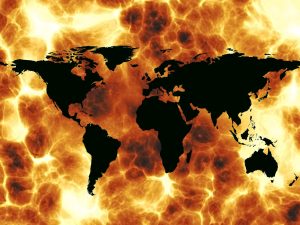
The ultra-wealthy’s latest status symbol isn’t a super-yacht or private island — it’s a luxury survival bunker. From New Zealand’s exclusive retreats to underground complexes in Montana, billionaires are spending millions on fortified sanctuaries designed to weather civilization’s collapse. But these elaborate preparations reveal a fundamental misunderstanding of how disasters actually unfold and may create more problems than they solve.
While the idea of the “social construct” has been ballyhooed almost to death in the early 21st Century, it is a solid and verifiable doctrinal base. At the same time, the antithesis is also true…and in this context, the statement that “wealth is a social construct” is also a fundamental truth.
Although many people at the lower end of the economic spectrum may rage aginst the idea that they are taking part in a “social construct” from the moment they wake up in the morning, for the ultra-rich, the idea has been slowly growing that their wealth equates to them the level and aspects of medieval barons, that their wealth can insulate them from catastrophic events, events that result in a “Mad Max/Road Warrior” type of world. It is important to remember that the so-called “Robber Barons” of the late-19th Century in America and Europe may have been rapacious, but they were careful to cultivate actual loyalty among their guard forces.
For the modern mega-wealthy, such an attitude is what is known as “whistling past the graveyard“, a phenomenon best represented by the “luxury survival bunker“.
The modern luxury bunker industry promises the impossible: maintaining elite levels of comfort and safety while civilization burns above. Companies like Vivos and Rising S offer underground mansions complete with wine cellars, home theaters, and hydroponic gardens. The Survival Condo Project in Kansas converted a former missile silo into luxury apartments selling for millions, featuring a swimming pool, rock climbing wall, and armored vehicles. The implicit promise is that money can buy not just survival, but the preservation of pre-disaster lifestyle.

This approach fundamentally misunderstands disaster dynamics. Real catastrophes — whether economic collapse, climate disasters, or social upheaval — require adaptation, community cooperation, and practical skills, not isolation behind reinforced concrete. History shows that those who survive major disruptions are typically embedded in resilient communities with diverse skill sets, not isolated individuals hoarding resources.
We’re not talking about official, taxpayer-maintained “continuity of government” bunkers like Mount Weather, Raven’s Rock, or military command centers like the Cheyenne Mountain Complex. No, we’re talking about private residences purchased by the ultra-rich.

The bunker mentality creates several critical vulnerabilities for both survival and immediate security. First, these facilities become obvious targets once their existence becomes known. A luxury bunker essentially advertises its contents to anyone desperate enough to attempt breaching it. The very features that make them appealing — visible wealth, sophisticated systems, stockpiled resources — make them magnets for organized groups with nothing to lose.
Second, luxury bunkers require massive ongoing maintenance and technical expertise that their wealthy occupants rarely possess. Climate controls, water filtration, communications equipment, and power systems all demand specialized knowledge. When the contracted maintenance crews can’t or won’t reach the facility, these sophisticated systems become expensive liabilities. A billionaire who can’t repair a generator is far worse off than a farmer with a hand pump.
Third, the psychological toll of bunker life contradicts its luxury branding. Extended isolation, even in comfortable surroundings, creates mental health challenges that luxury amenities can’t address. Humans require social interaction, purpose, and connection to larger communities. A gold-plated prison cell is still a prison cell, and the mental deterioration that follows undermines the clear thinking necessary for actual survival.
The real self-defeating irony is economic. The resources spent on individual bunkers could create far more security if invested in community resilience, renewable infrastructure, or addressing the root causes of potential disasters. A billionaire who spent bunker money on local food security, renewable energy projects, or disaster preparedness for entire regions would be far safer than one hiding underground with a wine collection.
The bunker fantasy reflects the same thinking that created many of our current vulnerabilities, chiefly the belief that individual wealth can solve mass social inequality, and the fact that systemic risks require community-level responses, not individual escape plans. By definition, if society has collapsed enough to require bunker living, the economic systems that created that wealth no longer exist to maintain the bunker’s operations.
Genuine resilience comes from building robust, interconnected systems and communities capable of adapting to change. The wealthy would be better served by investing in the social fabric that sustains civilization — or which can at least “restart” it — rather than planning its abandonment. After all, if your survival plan assumes everyone else has failed, you’ve probably misunderstood both the problem and the solution.
True security isn’t found in isolation — it’s built through interdependence, community investment, and addressing challenges collectively rather than hiding from them individually.
But there is another psychological area to address: the delusion of “elite leadership.”
Leadership is only hard when you’re not humble…and getting into the category of being among the “ultra-rich” argues strongly against humility. “Humble” people do not vacation at Lake Como or along the Riviera on a yacht that costs more than a mid-sized city’s fire department engines. Consider the battle-hardened special-ops veterans the ultra-wealthy hire as “private security” (whether they actually know what “executive protection details” actually entail): As long as the world is intact, and the paychecks continue to flow, sure, they are happy to protect – even in lethal situations – the person and family of the person signing their checks.
But really – when everything goes to hell, who is that elite Operator going to put first: the tech-bro whose money is now so much vaporware, or their own family? Think about it.
All of the above being said, preparing for disasters – even “mega-disasters” – is not wrong. It is highly prudent and advisable. But don’t expect that burning your credit card limits on stuff will save you. Supplies are good. Training is vital. But should the worst ever happen, you are not a “lone wolf”, whether you have a family or not.
Act accordingly.









